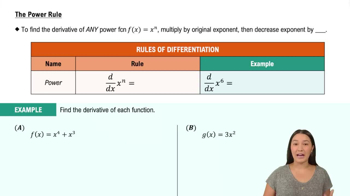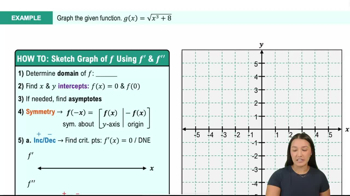Table of contents
- 0. Functions7h 52m
- Introduction to Functions16m
- Piecewise Functions10m
- Properties of Functions9m
- Common Functions1h 8m
- Transformations5m
- Combining Functions27m
- Exponent rules32m
- Exponential Functions28m
- Logarithmic Functions24m
- Properties of Logarithms34m
- Exponential & Logarithmic Equations35m
- Introduction to Trigonometric Functions38m
- Graphs of Trigonometric Functions44m
- Trigonometric Identities47m
- Inverse Trigonometric Functions48m
- 1. Limits and Continuity2h 2m
- 2. Intro to Derivatives1h 33m
- 3. Techniques of Differentiation3h 18m
- 4. Applications of Derivatives2h 38m
- 5. Graphical Applications of Derivatives6h 2m
- 6. Derivatives of Inverse, Exponential, & Logarithmic Functions2h 37m
- 7. Antiderivatives & Indefinite Integrals1h 26m
- 8. Definite Integrals4h 44m
- 9. Graphical Applications of Integrals2h 27m
- 10. Physics Applications of Integrals 2h 22m
5. Graphical Applications of Derivatives
Curve Sketching
Problem 3.6.56c
Textbook Question
{Use of Tech} Power and energy Power and energy are often used interchangeably, but they are quite different. Energy is what makes matter move or heat up. It is measured in units of joules or Calories, where 1 Cal=4184 J. One hour of walking consumes roughly 10⁶J, or 240 Cal. On the other hand, power is the rate at which energy is used, which is measured in watts, where 1 W=1 J/s. Other useful units of power are kilowatts (1 kW=10³ W) and megawatts (1 MW=10⁶ W). If energy is used at a rate of 1 kW for one hour, the total amount of energy used is 1 kilowatt-hour (1 kWh=3.6×10⁶ J) Suppose the cumulative energy used in a large building over a 24-hr period is given by E(t)=100t+4t²−t³ / 9kWh where t=0 corresponds to midnight.
c. Graph the power function and interpret the graph. What are the units of power in this case?
 Verified video answer for a similar problem:
Verified video answer for a similar problem:This video solution was recommended by our tutors as helpful for the problem above
Video duration:
3mPlay a video:
Was this helpful?
Key Concepts
Here are the essential concepts you must grasp in order to answer the question correctly.
Energy vs. Power
Energy is the capacity to do work or produce heat, measured in joules (J) or calories (Cal). Power, on the other hand, is the rate at which energy is consumed or produced, measured in watts (W), where 1 W equals 1 J/s. Understanding the distinction between these two concepts is crucial for analyzing how energy is utilized over time.
Recommended video:

The Power Rule
Cumulative Energy Function
The cumulative energy function E(t) = 100t + 4t² - t³ represents the total energy consumed over time, where t is measured in hours. This function allows us to calculate the energy used at any given time and is essential for determining the power function by differentiating E(t) with respect to time.
Recommended video:

Properties of Functions
Graphing Power Function
To graph the power function, we first derive it from the cumulative energy function, which gives us the rate of energy consumption at any time t. The resulting power function will be plotted against time, allowing us to visualize how power usage changes throughout the day. The units of power in this context will be in kilowatts (kW), reflecting the energy consumption rate.
Recommended video:

Graph of Sine and Cosine Function

 11:41m
11:41mWatch next
Master Summary of Curve Sketching with a bite sized video explanation from Callie
Start learning




